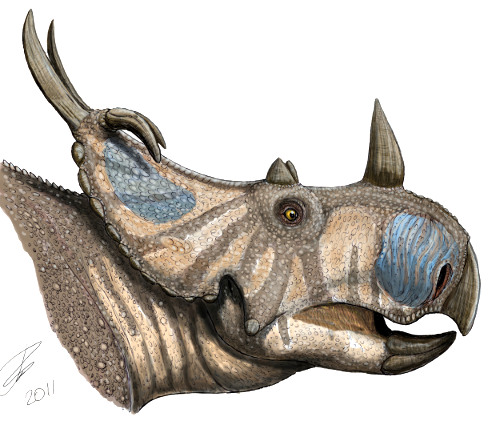Spinops sternbergorum lived approximately 76 million years ago in southern Alberta, Canada, so technically the discovery was 76 million years in the making rather than 100, but the Anthropic Principle favored by string proponents in physics says nothing counts unless we perceive it so that counts for paleontology also, it would seem. Spinops was a plant-eater that weighed around two tons when alive and was a smaller cousin of Triceratops. A single large horn projected from the top of the nose, and a bony neck frill sported at least two long, backward-projecting spikes as well as two forward-curving hooks. These unique structures distinguish Spinops from related horned dinosaurs.
Parts of the skulls of at least two Spinops were discovered in 1916 by Charles H. and Levi Sternberg, a father-and-son fossil collecting team. The Sternbergs recognized that their find represented a new species and sent the fossils to The Natural History Museum (London). However, the fossils were deemed too scrappy for exhibit, and consequently were shelved for decades. It wasn't until paleontologists recognized the importance of the fossil that the bones were finally cleaned for study.
The name Spinops sternbergorum (pronounced "SPIN-ops stern-berg-OR-uhm") means "Sternbergs' spine face", referring to the headgear of the animal and honoring the original discoverers of the fossil.

Artistic reconstruction of Spinops sternbergorum. Credit: Copyright Dmitry Bogdanov; skull reconstruction copyright Lukas Panzarin, Raymond M. Alf Museum of Paleontology
Although the face of Spinops is similar to its close relatives Centrosaurus and Styracosaurus, the unique anatomy of the bony neck frill gives scientists better insight into how this structure evolved. In particular, the fossils of Spinops clarify the identification of the long frill spikes common in some horned dinosaurs.
Previously, scientists had inferred that these spikes evolved only once in the group. Careful study of Spinops, however, suggests that its spikes are located in a different position from that seen in most other horned dinosaurs, implying that the structures evolved independently.
"This animal is an important addition to our understanding of horned dinosaur diversity and evolution," said Andrew Farke, Augustyn Family Curator of Paleontology at the Raymond M. Alf Museum of Paleontology, and lead author on the study naming Spinops. "This study highlights the importance of museum collections for understanding the history of our planet. My colleagues and I were pleasantly surprised to find these fossils on the museum shelf, and even more astonished when we determined that they were a previously unknown species of dinosaur."
Citation: Farke, A. A., M. J. Ryan, P. M. Barrett, D. H. Tanke, D. R. Braman, M. A. Loewen, and M. R. Graham. 2011. A new centrosaurine from the Late Cretaceous of Alberta, Canada, and the evolution of parietal ornamentation in horned dinosaurs. Acta Palaeontologica Polonica 56(4). doi:10.4202/app.2010.0121






Comments